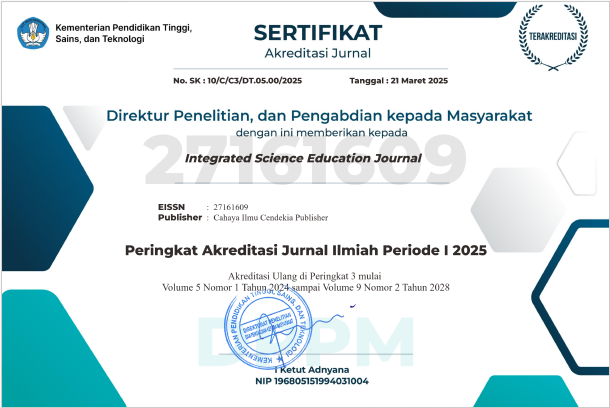Efforts to Improve Student Activities and Outcomes in Physics Learning Using the Two Stay Two Stray Technical Cooperative Learning Model at Senior High School
Abstract
Purpose of the study: The research aims to increase students' activity and learning outcomes in Class X in Senior high school 10 Kota Jambi.
Methodology: The research method used is mixed. This research is a Classroom Action Research carried out in three cycles. Retrieval of qualitative data using student activity observation sheets and teacher activity during the teaching and learning process. Retrieval of quantitative data in the form of objective tests held at the end of each learning cycle.
Main findings: From the results of the study, it showed that there was an increase in learning outcomes for each cycle, namely, 59.53 for the cycle I to 69.38 for cycle II and 75.48 for cycle III. While increasing the average percentage of student activity. In cycle I was 47.24%, the average percentage of student activity increased to 60.17% in cycle II, and experienced another increase in cycle III to 70.87%.
Novelty/Originality of this study: That research using the two stay two stray learning model to improve learning outcomes is very little done in high schools, mostly the application of the two stay two stray model is applied in elementary schools
References
I. K. Sudarsana., A. R. Nakayanti., A. Sapta., E. Satria., K. Saddhono., G. A. Daengs., and M. Mursalin, (2019, November). Technology application in education and learning process. In Journal of Physics: Conference Series (Vol. 1363, No. 1, p. 012061). IOP Publishing, 2019.
A. Afrina., E. W. Abbas., and H. Susanto, “The Role of Historical Science in Social Studies Learning Materials for Increasing Values of Student's Nationalism,” The Innovation of Social Studies Journal, vol. 3, no. 1, pp. 1-8, 2021.
S. Maâ, “Telaah Teoritis: Apa Itu Belajar?,” HELPER: Jurnal Bimbingan dan Konseling, vol. 35, no. 1, pp. 31-46, 2018.
S. R. Putri., S. Wahyuni., and P. Suharso, “Penggunaan media pembelajaran edmodo untuk meningkatkan aktivitas dan hasil belajar siswa Kelas X Pemasaran di SMK Negeri 1 Jember Tahun Ajaran 2016/2017,” Jurnal Pendidikan Ekonomi: Jurnal Ilmiah Ilmu Pendidikan, Ilmu Ekonomi dan Ilmu Sosial, vol. 11, no. 2, pp. 108-114, 2018.
R. Capone, “Blended learning and student-centered active learning environment: a case study with STEM undergraduate students,” Canadian Journal of Science, Mathematics and Technology Education, vol. 22, no. 1, pp. 210-236, 2022.
A. C. Mingorance-Estrada., J. G. Vera., G. R. Ruiz., and I. A. Arrebola, “Flipped classroom to improve university student centered learning and academic performance,” Social Sciences, vol. 8, no. 11, pp. 315, 2019.
G. S. Goloshumova., O. V. Ershova., V. B. Salakhova., A. V. Kidinov., S. A. Nalichaeva., and V. A. Yanysheva, “Information and educational environment of higher school as a factor of the formation of coping strategies in the structure of students' personality (ecological and psychological aspect),” Eurasian journal of biosciences, vol. 13, no. 2, 2019.
J. Kim, “Learning and teaching online during Covid-19: Experiences of student teachers in an early childhood education practicum,” International Journal of Early Childhood, vol. 52, no. 2, pp. 145-158, 2020.
D. G. Erbil, “A review of flipped classroom and cooperative learning method within the context of Vygotsky theory,” Frontiers in Psychology, vol. 11, pp. 1157, 2020.
Y. Yusri., R. Mantasiah., and J. Jufri, “The use of Two Stay Two Stray Model in English teaching to increase student’s learning outcome,” Journal Of Advanced English Studies, vol. 1, no. 1, pp. 39-43, 2018.
F. Firman., N. Aswar., S. Sukmawaty., M. Mirnawati., and S. Sukirman, “Application of the Two Stay Two Stray Learning Model in Improving Indonesian Language Learning Outcomes in Elementary Schools,” Jurnal Studi Guru Dan Pembelajaran, vol. 3, no. 3, pp. 551-558, 2020
N. Rai., and B. Thapa, “A study on purposive sampling method in research,” Kathmandu:Kathmandu School of Law, pp. 1–12, 2015.
S. Arikunto, “Dasar –Dasar Evaluasi Pendidikan”. Jakarta: Bumi Aksara, 2013.
S. Arikunto., and S. Suhardjono, “Penelitian Tindakan Kelas”. Jakarta: Bumi Aksara, 2013.
F. Suryani, “Peningkatan Prestasi Siswa pada Konsep Fluida Statis dengan Model Pembelajaran Kooperatif Teknik Two Stay-Two Stray (TSTS) Bervariasi Demonstrasi di Kelas XI IPA SMA Negeri 5 Yogyakarta TA 2012/2013,” Yogyakarta: Universitas Ahmad Dahlan, 2014.
L. S. L. Purba, “Pengaruh penerapan model pembelajaran kooperatif tipe two stay-two stray (TS-TS) terhadap hasil belajar dan aktivitas belajar siswa pada pokok bahasan koloid,” EduMatSains: Jurnal Pendidikan, Matematika dan Sains, vol. 1, no. 2, pp. 137-152, 2017.
E. Rozal., R. Ananda., A. Zb., M. Fauziddin., and F. Sulman, “The Effect of Project-Based Learning through YouTube Presentations on English Learning Outcomes in Physics," AL-Ishlah: Jurnal Pendidikan, vol. 13, no. 3, pp. 1924-1933, 2021.
L. Astuti., Y. Wihardi., and D. Rochintaniawati, “The Development of Web-Based Learning Using Interactive Media for Science Learning on Levers in Human Body Topic,” Journal of Science Learning, vol. 3, no. 2, pp. 89-98, 2020.
R. M. Ryan., and E. L. Deci, “Intrinsic and extrinsic motivation from a self-determination theory perspective: Definitions, theory, practices, and future directions,” Contemporary educational psychology, vol. 61, 101860, 2020.
R. Kaše., T. Saksida., and K. K. Mihelič, “Skill development in reverse mentoring: Motivational processes of mentors and learners,” Human Resource Management, vol. 58, no. 1, pp. 57-69, 2019.
Copyright (c) 2023 Mulyati Mulyati, Fhadira Insani Putri, Deswalman Deswalman

This work is licensed under a Creative Commons Attribution-NonCommercial 4.0 International License.
Authors who publish with this journal agree to the following terms:
- Authors retain copyright and acknowledge that the Integrated Science Education Journal is the first publisher licensed under a Creative Commons Attribution 4.0 International License.
- Authors are able to enter into separate, additional contractual arrangements for the non-exclusive distribution of the journal's published version of the work (e.g., post it to an institutional repository or publish it in a book), with an acknowledgment of its initial publication in this journal.
- Authors are permitted and encouraged to post their work online (e.g., in institutional repositories or on their website) prior to and during the submission process, as it can lead to productive exchanges and earlier and greater citation of published work.







.png)
.png)






